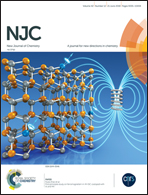Designed synthesis of ultrafine NiO nanocrystals bonded on a three dimensional graphene framework for high-capacity lithium-ion batteries†
Abstract
The rational design and controllable synthesis of novel nanostructured metal oxide/graphene hybrid materials have attracted extensive attention for next-generation lithium ion batteries (LIBs). In this work, three dimensional (3D) graphene framework bonding ultrafine NiO nanocrystals are fabricated in situ through hydrothermal treatment and a subsequent thermal annealing strategy. During the material design process, the 2D bark-like Ni precursor which duplicated the morphology of GO was formed firstly by adjusting the amount of the structure-directing agent. Meanwhile, the 3D interconnected framework of graphene can be obtained via π–π interaction. Subsequently, thermal treatment was performed to transform the Ni precursors into NiO nanocrystals with an average particle size of 6.38 nm. The chemical bonding between the NiO nanocrystals and the graphene framework was confirmed by Raman and XPS analysis. Benefiting from the unique architecture, the hybrid anode material exhibits an ultrahigh reversible capacity of 1104 mA h g−1 at a rate of 0.2C after 250 successive cycles, and an outstanding rate capability (440 mA h g−1 at 3.0C). Moreover, superior capacity retention is also demonstrated.



 Please wait while we load your content...
Please wait while we load your content...